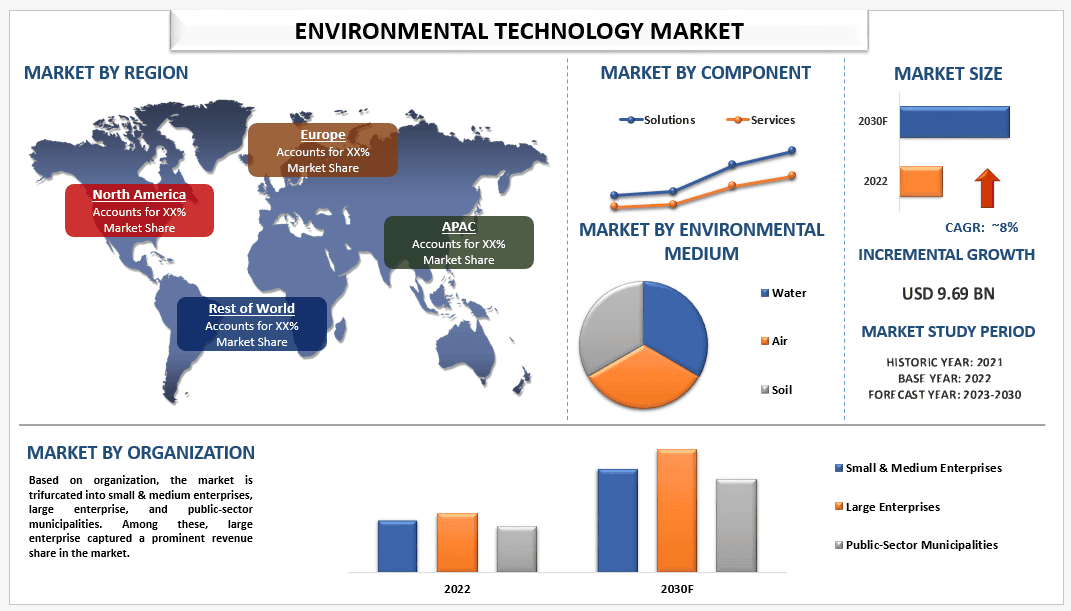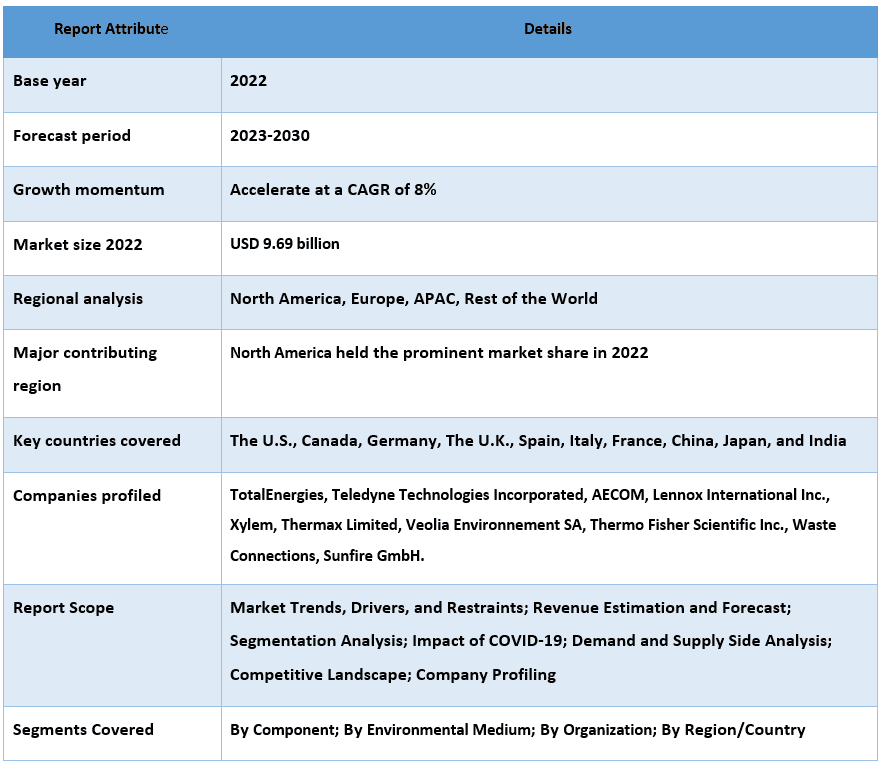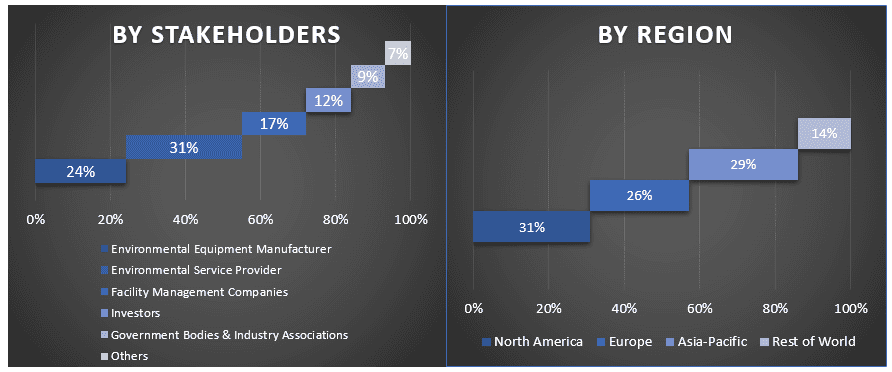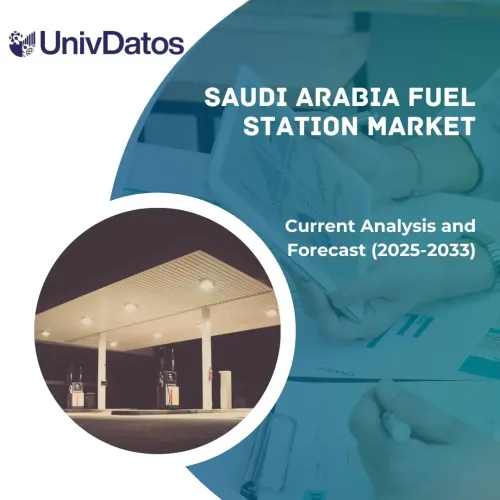- Home
- Chi siamo
- Settore
- Servizi
- Lettura
- Contattaci
Mercato della tecnologia ambientale: analisi e previsioni attuali (2023-2030)
Enfasi su Componente (Soluzioni e Servizi); Ambiente (Acqua, Aria, Suolo); Organizzazione (Piccole e Medie Imprese, Grandi Imprese, Municipalità del Settore Pubblico) e Regione/Paese

Si prevede che il mercato globale della tecnologia ambientale cresca a un forte CAGR di circa l'8% durante il periodo di previsione (2023-2030).Il mercato è in crescita a causa delle normative governative sempre più severe per ridurre le attività di non conformità ambientale. Inoltre, la crescente domanda di risorse, unita alla scarsità di risorse, sta anche spingendo il mercato della tecnologia ambientale. Poiché le risorse ambientali giocano un ruolo chiave nella produzione industriale, il loro utilizzo aumenta la domanda di tecnologia per utilizzare e riutilizzare in modo efficiente le risorse.Ad esempio, nell'attuale scenario negli Stati Uniti, l'industria del trattamento e del riutilizzo delle acque sta assistendo a grandi investimenti e sviluppi per produrre gas naturale utilizzando tecniche di fratturazione idraulica a causa dell'alto costo dell'acqua nelle operazioni di fratturazione idraulica.
Ad esempio, alcune delle leggi più importanti che controllano la tecnologia ambientale negli Stati Uniti sono il Resource Conservation and Recovery Act (RCRA), il Clean Air Act e il Clean Water Act. L'EPA offre anche diverse iniziative facoltative, come il programma Energy Star, per aiutare individui e aziende a ridurre il consumo di energia e le emissioni di gas serra.
Alcuni dei principali attori che operano nel mercato includono TotalEnergies, Teledyne Technologies Incorporated, AECOM, Lennox International Inc., Xylem, Thermax Limited, Veolia Environnement SA, Thermo Fisher Scientific Inc., Waste Connections, Sunfire GmbH.
Approfondimenti presentati nel rapporto
“Tra i componenti, la categoria dei servizi ha detenuto la quota di mercato più rilevante nel 2022 e si prevede che manterrà la sua posizione durante il periodo di previsione”
In base al componente, il mercato è suddiviso in soluzioni e servizi. Tra questi, la categoria dei servizi ha detenuto la quota di mercato più rilevante nel 2022 e si prevede che manterrà la sua posizione durante il periodo di previsione. Ciò è dovuto principalmente alla crescente domanda di risorse ambientali, alla corretta manutenzione, utilizzo, gestione dei rifiuti, recupero delle risorse e servizi di analisi per massimizzare l'efficienza delle risorse ambientali. Inoltre, per conformarsi alle severe normative governative, le aziende si avvalgono di servizi di ingegneria e consulenza per trasformare il proprio business. Questo fa aumentare il segmento dei servizi nel mercato globale della tecnologia ambientale.
“Tra le organizzazioni, le grandi imprese hanno acquisito una quota di ricavi significativa nel mercato”
In base all'organizzazione, il mercato è suddiviso in piccole e medie imprese, grandi imprese e municipalità del settore pubblico. Tra questi, le grandi imprese hanno acquisito una quota di ricavi significativa nel mercato grazie alle loro tecnologie avanzate in grado di affrontare diversi tipi di sfide ambientali. Il settore dell'elettricità, dell'energia e dei servizi pubblici dovrebbe essere il maggiore acquirente di tecnologie ambientali tra le grandi organizzazioni. Il crescente settore delle energie rinnovabili è in gran parte responsabile della significativa quota di mercato dei settori dell'elettricità, dell'energia e dei servizi pubblici.
Copertura del rapporto sul mercato della tecnologia ambientale

“Si prevede che l'Europa registrerà il più alto tasso di crescita nel periodo di previsione”
Si prevede che il mercato europeo registrerà il più alto tasso di crescita nel periodo di previsione. Ciò è dovuto principalmente agli ampi investimenti di numerose nazioni nel solare, nell'eolico e nell'energia idroelettrica all'interno della regione. L'Europa svolge un ruolo significativo nello sviluppo della tecnologia delle energie rinnovabili. Varie aziende nella regione stanno anche lavorando su tecnologie all'avanguardia per l'accumulo di energia come batterie e celle a combustibile a idrogeno per contrastare la natura irregolare delle fonti di energia rinnovabile. Con molte nazioni che perseguono politiche e programmi per promuovere l'uso di case, elettrodomestici e sistemi di trasporto ad alta efficienza energetica, l'Europa dispone anche di tecnologie di efficienza energetica.Ad esempio, nel 2021, Siemens ha annunciato l'intenzione di diventare carbon-neutral entro il 2030, con particolare attenzione allo sviluppo di tecnologie di energia rinnovabile e soluzioni ad alta efficienza energetica per i suoi clienti. Siemens sta anche espandendo il suo portafoglio di soluzioni per infrastrutture intelligenti, tra cui infrastrutture di ricarica per veicoli elettrici e sistemi di gestione dell'energia.
Motivi per acquistare questo rapporto:
- Lo studio include la dimensionamento del mercato e l'analisi delle previsioni convalidata da esperti chiave del settore autenticati
- Il rapporto presenta una rapida panoramica delle prestazioni complessive del settore a colpo d'occhio
- Il rapporto copre un'analisi approfondita dei principali attori del settore con particolare attenzione ai principali dati finanziari aziendali, al portafoglio prodotti, alle strategie di espansione e agli sviluppi recenti
- Esame dettagliato di fattori trainanti, vincoli, tendenze chiave e opportunità prevalenti nel settore
- Lo studio copre in modo completo il mercato in diversi segmenti
- Analisi approfondita del settore a livello di paese
Opzioni di personalizzazione:
Il mercato globale della tecnologia ambientale può essere ulteriormente personalizzato in base alle esigenze o a qualsiasi altro segmento di mercato. Oltre a ciò, UMI capisce che potresti avere le tue esigenze aziendali, quindi non esitare a metterti in contatto con noi per ottenere un rapporto che soddisfi completamente le tue esigenze.
Indice
Metodologia di ricerca per l'analisi del mercato globale della tecnologia ambientale (2023-2030)
L'analisi del mercato storico, la stima del mercato attuale e la previsione del mercato futuro della tecnologia ambientale sono le tre fasi principali intraprese per creare e analizzare la sua adozione in tutto il mondo. È stata condotta un'ampia ricerca secondaria per raccogliere i numeri storici del mercato e stimare le dimensioni attuali del mercato. In secondo luogo, per convalidare questi approfondimenti, sono state prese in considerazione numerose scoperte e ipotesi. Inoltre, sono stati condotti anche ampi colloqui primari con esperti del settore lungo la catena del valore del settore della tecnologia ambientale. Dopo l'assunzione e la convalida dei numeri di mercato attraverso interviste primarie, abbiamo impiegato un approccio bottom-up per prevedere le dimensioni complete del mercato. Successivamente, sono stati adottati metodi di scomposizione del mercato e di triangolazione dei dati per stimare e analizzare le dimensioni del mercato dei segmenti e dei sottosegmenti a cui appartiene il settore. La metodologia dettagliata è spiegata di seguito:
Analisi delle dimensioni storiche del mercato
Fase 1: studio approfondito delle fonti secondarie:
È stato condotto uno studio secondario dettagliato per ottenere le dimensioni storiche del mercato della tecnologia ambientale attraverso fonti interne all'azienda comerelazione annuale e bilanci, presentazioni sulle prestazioni, comunicati stampa, ecc.e fonti esterne tra cuiriviste, notizie e articoli, pubblicazioni governative, pubblicazioni dei concorrenti, rapporti settoriali, database di terze parti e altre pubblicazioni credibili.
Fase 2: Segmentazione del mercato:
Dopo aver ottenuto le dimensioni storiche del mercato della tecnologia ambientale, abbiamo condotto un'analisi secondaria dettagliata per raccogliere approfondimenti e quote di mercato correnti per diversi segmenti e sottosegmenti per le principali regioni. I principali segmenti inclusi nel rapporto sono per componente, ambiente e organizzazione. Ulteriori analisi a livello regionale e nazionale sono state condotte per valutare l'adozione complessiva della tecnologia ambientale a livello globale.
Fase 3: analisi dei fattori:
Dopo aver acquisito le dimensioni storiche del mercato di diversi segmenti e sottosegmenti, abbiamo condotto un'analisi dettagliataanalisi dei fattoriper stimare le dimensioni attuali del mercato della tecnologia ambientale. Inoltre, abbiamo condotto un'analisi dei fattori utilizzando variabili dipendenti e indipendenti come l'aumento delle iniziative governative per proteggere l'ambiente e la crescente preoccupazione per la scarsità di risorse. È stata condotta un'analisi approfondita per lo scenario della domanda e dell'offerta considerando l'aumento degli investimenti, le principali partnership, le fusioni e le acquisizioni, l'espansione del business e i lanci di prodotti nel settore della tecnologia ambientale.
Stima e previsione delle dimensioni attuali del mercato
Dimensionamento del mercato attuale:Sulla base di approfondimenti attuabili dalle 3 fasi precedenti, siamo giunti alle dimensioni attuali del mercato, ai principali attori nel mercato globale della tecnologia ambientale e alle quote di mercato di ciascun segmento. Tutte le quote percentuali divise richieste e le scomposizioni del mercato sono state determinate utilizzando l'approccio secondario sopra menzionato e sono state verificate attraverso interviste primarie.
Stima e previsione:Per la stima e le previsioni del mercato, sono stati assegnati pesi a diversi fattori, tra cui fattori trainanti e tendenze, vincoli e opportunità disponibili per le parti interessate. Dopo aver analizzato questi fattori, sono state applicate tecniche di previsione pertinenti, ovvero l'approccio top-down/bottom-up, per arrivare alle previsioni di mercato per il 2030 per diversi segmenti e sottosegmenti nei principali mercati a livello globale. La metodologia di ricerca adottata per stimare le dimensioni del mercato comprende:
- Le dimensioni del mercato del settore, in termini di ricavi (USD) e il tasso di adozione del mercato degli elettrodomestici per la cura dei capelli nei principali mercati a livello nazionale
- Tutte le quote percentuali, suddivisioni e ripartizioni dei segmenti e sotto-segmenti di mercato
- Attori chiave nel mercato globale degli elettrodomestici per la cura dei capelli in termini di prodotti offerti. Inoltre, le strategie di crescita adottate da questi attori per competere nel mercato in rapida crescita
Validazione delle Dimensioni e della Quota di Mercato
Ricerca Primaria:Sono stati condotti colloqui approfonditi con i Key Opinion Leader (KOL) tra cui Top Level Executive (CXO/VP, Responsabile Vendite, Responsabile Marketing, Responsabile Operativo e Responsabile Regionale, Responsabile Paese, ecc.) in tutte le principali regioni. I risultati della ricerca primaria sono stati poi riassunti e sono state eseguite analisi statistiche per dimostrare l'ipotesi dichiarata. Gli input dalla ricerca primaria sono stati consolidati con i risultati secondari, trasformando quindi le informazioni in approfondimenti attuabili.
Suddivisione dei Partecipanti Primari in Diverse Regioni

Ingegneria di Mercato
La tecnica di triangolazione dei dati è stata impiegata per completare la stima complessiva del mercato e per arrivare a numeri statistici precisi di ogni segmento e sotto-segmento del mercato globale della tecnologia ambientale. I dati sono stati suddivisi in diversi segmenti e sotto-segmenti dopo aver studiato vari parametri e tendenze nelle aree di componente, mezzo ambientale e organizzazione.
L'obiettivo principale dello studio di mercato della tecnologia ambientale
Le attuali e future tendenze del mercato globale della tecnologia ambientale sono state individuate nello studio. Gli investitori possono ottenere approfondimenti strategici per basare la propria discrezionalità sugli investimenti dall'analisi qualitativa e quantitativa eseguita nello studio. Le attuali e future tendenze del mercato determineranno l'attrattiva complessiva del mercato a livello nazionale, fornendo una piattaforma per il partecipante industriale per sfruttare il mercato inesplorato a beneficio del vantaggio del primo ad agire. Altri obiettivi quantitativi degli studi includono:
- Analizzare le dimensioni attuali e previste del mercato della tecnologia ambientale in termini di valore (USD). Inoltre, analizzare le dimensioni attuali e previste del mercato dei diversi segmenti e sotto-segmenti
- I segmenti nello studio includono aree di componenti, mezzo ambientale e organizzazione
- Analisi definita del quadro normativo per l'industria della tecnologia ambientale
- Analizzare la catena del valore coinvolta con la presenza di vari intermediari, insieme all'analisi dei comportamenti di clienti e concorrenti del settore
- Analizzare le dimensioni attuali e previste del mercato della tecnologia ambientale per i principali paesi
- I principali paesi delle regioni studiate nel rapporto includono Asia Pacifico, Europa, Nord America e Resto del Mondo
- Profili aziendali degli attori del mercato della tecnologia ambientale e le strategie di crescita da loro adottate per sostenersi nel mercato in crescita
Analisi approfondita del settore a livello nazionale
Correlati Report
I clienti che hanno acquistato questo articolo hanno acquistato anche










